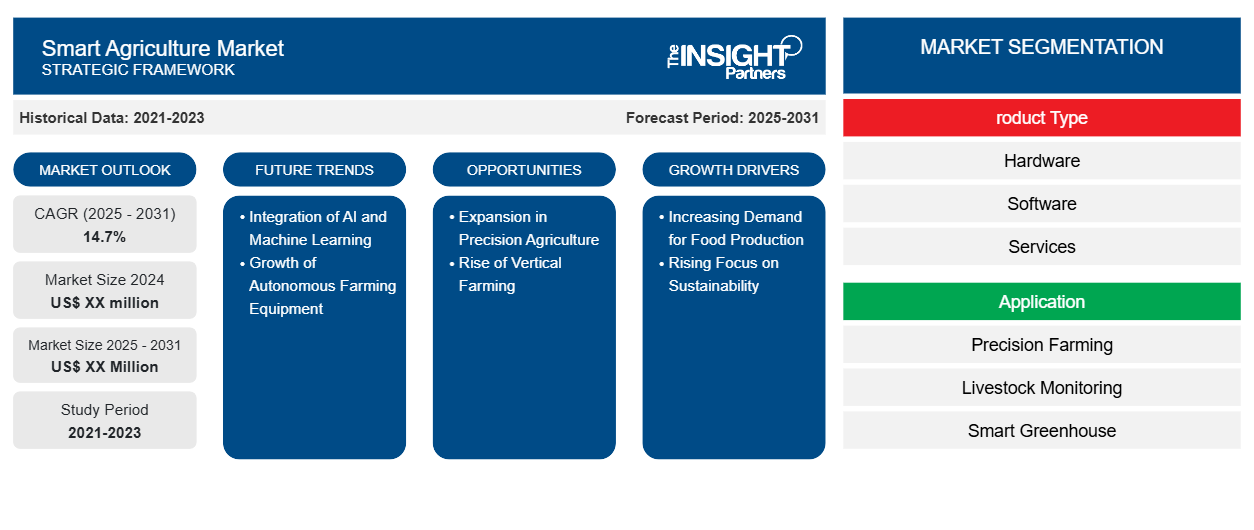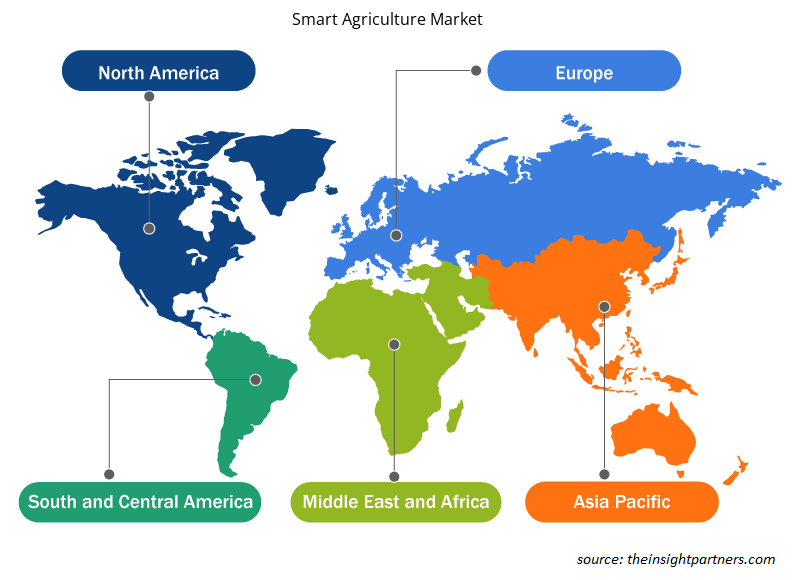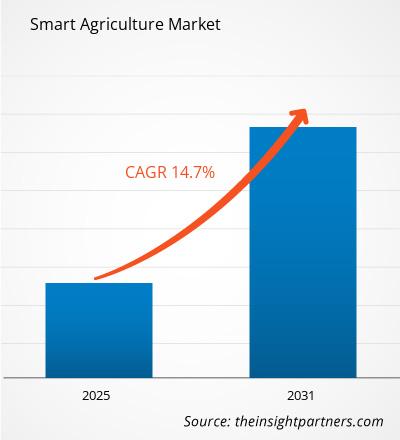The Smart Agriculture Market is expected to register a CAGR of 14.7% from 2025 to 2031, with a market size expanding from US$ XX million in 2024 to US$ XX Million by 2031.
The report is segmented by Product Type (Hardware, Software, and Services) and Application (Precision Farming, Livestock Monitoring, Smart Greenhouse, and Others). The global analysis is further broken-down at regional level and major countries. The report offers the value in USD for the above analysis and segments
Purpose of the Report
The report Smart Agriculture Market by The Insight Partners aims to describe the present landscape and future growth, top driving factors, challenges, and opportunities. This will provide insights to various business stakeholders, such as:
- Technology Providers/Manufacturers: To understand the evolving market dynamics and know the potential growth opportunities, enabling them to make informed strategic decisions.
- Investors: To conduct a comprehensive trend analysis regarding the market growth rate, market financial projections, and opportunities that exist across the value chain.
- Regulatory bodies: To regulate policies and police activities in the market with the aim of minimizing abuse, preserving investor trust and confidence, and upholding the integrity and stability of the market.
Smart Agriculture Market Segmentation
roduct Type
- Hardware
- Software
- Services
Application
- Precision Farming
- Livestock Monitoring
- Smart Greenhouse
- Others.
You will get customization on any report - free of charge - including parts of this report, or country-level analysis, Excel Data pack, as well as avail great offers and discounts for start-ups & universities
Smart Agriculture Market: Strategic Insights

- Get Top Key Market Trends of this report.This FREE sample will include data analysis, ranging from market trends to estimates and forecasts.
Smart Agriculture Market Growth Drivers
- Increasing Demand for Food Production: With the global population growing rapidly, the demand for food is at an all-time high. Smart agriculture solutions, including precision farming, IoT sensors, and automated machinery, help optimize farming practices to meet these demands. These technologies enable farmers to increase crop yields, reduce waste, and improve resource management, thus addressing the need for more efficient food production systems to feed the world’s growing population.
- Rising Focus on Sustainability: Sustainability is becoming a major concern in agriculture due to climate change, resource depletion, and environmental degradation. Smart agriculture technologies help farmers adopt more sustainable practices by optimizing water use, reducing chemical inputs, and minimizing waste. Technologies like drones, soil sensors, and automated irrigation systems enable more efficient resource management, promoting environmental stewardship while maintaining productivity.
Smart Agriculture Market Future Trends
- Integration of AI and Machine Learning: Artificial intelligence (AI) and machine learning (ML) are increasingly being integrated into smart agriculture systems. These technologies analyze vast amounts of data collected from sensors, drones, and satellites, providing actionable insights for farmers. AI and ML can predict weather patterns, optimize planting schedules, detect pests, and enhance crop management, improving decision-making and overall farm efficiency.
- Growth of Autonomous Farming Equipment: The adoption of autonomous vehicles and machinery is a growing trend in smart agriculture. Tractors, harvesters, and drones equipped with GPS and sensors are becoming more common. These autonomous systems reduce labor costs, improve accuracy, and enable 24/7 operations, allowing farmers to optimize field operations such as planting, fertilizing, and harvesting with minimal human intervention, increasing productivity and reducing operational costs.
Smart Agriculture Market Opportunities
- Expansion in Precision Agriculture: Precision agriculture is one of the most significant opportunities for smart agriculture. By using advanced technologies such as GPS-guided tractors, drones, and soil sensors, farmers can monitor and manage crops at an unprecedented level of detail. This can result in increased crop yields, reduced waste, and more efficient use of inputs like water and fertilizers, creating substantial growth potential in the agriculture technology space.
- Rise of Vertical Farming: Vertical farming, an innovative approach that allows crops to be grown in stacked layers or controlled environments, offers significant opportunities for smart agriculture technologies. Automated systems for lighting, temperature, irrigation, and nutrient delivery are crucial for maximizing space and efficiency. As urbanization grows, vertical farming can provide a solution for local food production, reducing transportation costs and ensuring fresh produce year-round.
Smart Agriculture Market Regional Insights
The regional trends and factors influencing the Smart Agriculture Market throughout the forecast period have been thoroughly explained by the analysts at Insight Partners. This section also discusses Smart Agriculture Market segments and geography across North America, Europe, Asia Pacific, Middle East and Africa, and South and Central America.

- Get the Regional Specific Data for Smart Agriculture Market
Smart Agriculture Market Report Scope
| Report Attribute | Details |
|---|---|
| Market size in 2024 | US$ XX million |
| Market Size by 2031 | US$ XX Million |
| Global CAGR (2025 - 2031) | 14.7% |
| Historical Data | 2021-2023 |
| Forecast period | 2025-2031 |
| Segments Covered |
By roduct Type
|
| Regions and Countries Covered | North America
|
| Market leaders and key company profiles |
Smart Agriculture Market Players Density: Understanding Its Impact on Business Dynamics
The Smart Agriculture Market is growing rapidly, driven by increasing end-user demand due to factors such as evolving consumer preferences, technological advancements, and greater awareness of the product's benefits. As demand rises, businesses are expanding their offerings, innovating to meet consumer needs, and capitalizing on emerging trends, which further fuels market growth.
Market players density refers to the distribution of firms or companies operating within a particular market or industry. It indicates how many competitors (market players) are present in a given market space relative to its size or total market value.
Major Companies operating in the Smart Agriculture Market are:
- AGCO Corporation
- Ag Junction Inc.
- AG Leader Technology
- Deere & Company
- Raven Industries
- Inc.
Disclaimer: The companies listed above are not ranked in any particular order.

- Get the Smart Agriculture Market top key players overview
Key Selling Points
- Comprehensive Coverage: The report comprehensively covers the analysis of products, services, types, and end users of the Smart Agriculture Market, providing a holistic landscape.
- Expert Analysis: The report is compiled based on the in-depth understanding of industry experts and analysts.
- Up-to-date Information: The report assures business relevance due to its coverage of recent information and data trends.
- Customization Options: This report can be customized to cater to specific client requirements and suit the business strategies aptly.
The research report on the Smart Agriculture Market can, therefore, help spearhead the trail of decoding and understanding the industry scenario and growth prospects. Although there can be a few valid concerns, the overall benefits of this report tend to outweigh the disadvantages.
Frequently Asked Questions
What is the expected CAGR of smart agriculture market?
The Smart Agriculture Market is estimated to witness a CAGR of 14.7% from 2023 to 2031
What are the driving factors impacting global smart agriculture market?
Rise in digitalization and governmentiInvestment are the major factors driving the smart agriculture market.
What are the future trends of smart agriculture market?
Focus on Advanced Technology Integration are likely to remain a key trend in the market.
What are the deliverable formats of the smart agriculture market report?
The report can be delivered in PDF/PPT format; we can also share excel dataset based on the request
What are the options available for the customization of this report?
Some of the customization options available based on the request are an additional 3-5 company profiles and country-specific analysis of 3-5 countries of your choice. Customizations are to be requested/discussed before making final order confirmation# as our team would review the same and check the feasibility
- Historical Analysis (2 Years), Base Year, Forecast (7 Years) with CAGR
- PEST and SWOT Analysis
- Market Size Value / Volume - Global, Regional, Country
- Industry and Competitive Landscape
- Excel Dataset
Testimonials
I wish to appreciate your support and the professionalism you displayed in the course of attending to my request for information regarding to infectious disease IVD market in Nigeria. I appreciate your patience, your guidance, and the fact that you were willing to offer a discount, which eventually made it possible for us to close a deal. I look forward to engaging The Insight Partners in the future, all thanks to the impression you have created in me as a result of this first encounter.
DR CHIJIOKE ONYIA, MANAGING DIRECTOR, PineCrest Healthcare Ltd.The Insight Partners delivered insightful, well-structured market research with strong domain expertise. Their team was professional and responsive throughout. The user-friendly website made accessing industry reports seamless. We highly recommend them for reliable, high-quality research services
Yukihiko Adachi CEO, Deep Blue, LLC.Reason to Buy
- Informed Decision-Making
- Understanding Market Dynamics
- Competitive Analysis
- Customer Insights
- Market Forecasts
- Risk Mitigation
- Strategic Planning
- Investment Justification
- Identifying Emerging Markets
- Enhancing Marketing Strategies
- Boosting Operational Efficiency
- Tracking Industry Innovations
- Aligning with Regulatory Trends
Yes! We provide a free sample of the report, which includes Report Scope (Table of Contents), report structure, and selected insights to help you assess the value of the full report. Please click on the "Download Sample" button or contact us to receive your copy.
Absolutely — analyst assistance is part of the package. You can connect with our analyst post-purchase to clarify report insights, methodology or discuss how the findings apply to your business needs.
Once your order is successfully placed, you will receive a confirmation email along with your invoice.
• For published reports: You’ll receive access to the report within 4–6 working hours via a secured email sent to your email.
• For upcoming reports: Your order will be recorded as a pre-booking. Our team will share the estimated release date and keep you informed of any updates. As soon as the report is published, it will be delivered to your registered email.
We offer customization options to align the report with your specific objectives. Whether you need deeper insights into a particular region, industry segment, competitor analysis, or data cut, our research team can tailor the report accordingly. Please share your requirements with us, and we’ll be happy to provide a customized proposal or scope.
The report is available in either PDF format or as an Excel dataset, depending on the license you choose.
The PDF version provides the full analysis and visuals in a ready-to-read format. The Excel dataset includes all underlying data tables for easy manipulation and further analysis.
Please review the license options at checkout or contact us to confirm which formats are included with your purchase.
Our payment process is fully secure and PCI-DSS compliant.
We use trusted and encrypted payment gateways to ensure that all transactions are protected with industry-standard SSL encryption. Your payment details are never stored on our servers and are handled securely by certified third-party processors.
You can make your purchase with confidence, knowing your personal and financial information is safe with us.
Yes, we do offer special pricing for bulk purchases.
If you're interested in purchasing multiple reports, we’re happy to provide a customized bundle offer or volume-based discount tailored to your needs. Please contact our sales team with the list of reports you’re considering, and we’ll share a personalized quote.
Yes, absolutely.
Our team is available to help you make an informed decision. Whether you have questions about the report’s scope, methodology, customization options, or which license suits you best, we’re here to assist. Please reach out to us at sales@theinsightpartners.com, and one of our representatives will get in touch promptly.
Yes, a billing invoice will be automatically generated and sent to your registered email upon successful completion of your purchase.
If you need the invoice in a specific format or require additional details (such as company name, GST, or VAT information), feel free to contact us, and we’ll be happy to assist.
Yes, certainly.
If you encounter any difficulties accessing or receiving your report, our support team is ready to assist you. Simply reach out to us via email or live chat with your order information, and we’ll ensure the issue is resolved quickly so you can access your report without interruption.















The List of Companies - Smart Agriculture Market
1. AGCO Corporation
2. Ag Junction Inc.
3. AG Leader Technology
4. Deere & Company
5. Raven Industries, Inc.
6. Semiosbio Technologies Inc.
7. SST Development Group, Inc.
8. Teejet Technologies
9. Topcon Precision Agriculture
10. Trimble Navigation Limited among others.






 Get Free Sample For
Get Free Sample For